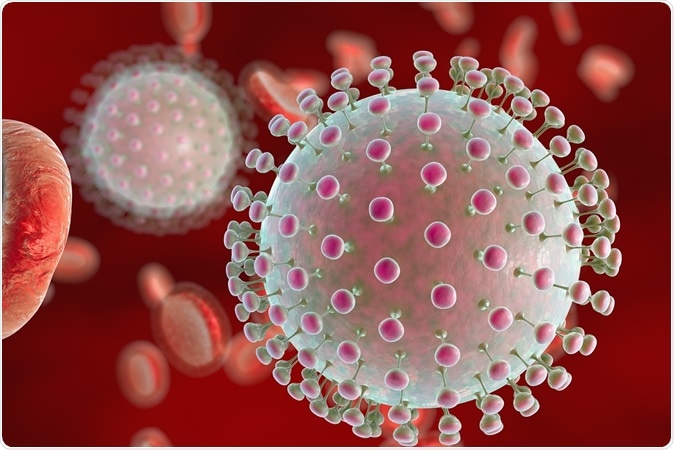According to a latest study supported by the National Institute of Allergy and Infectious Diseases (NIAID), a part of the National Institutes of Health, the deadly Zika virus could be used to kill a specific type of brain cancer cells and sparing the neighbouring healthy brain cells.
Although experimental in stage, this finding has wide implications for those suffering from these cancers.
The study entitled, “Zika virus has oncolytic activity against glioblastoma stem cells”, appeared in the September 5 online issue of The Journal of Experimental Medicine.

Illustration of Zika virus in blood with red blood cells, a virus which causes Zika fever. Image Credit: Kateryna Kon / Shutterstock
The researchers looked at the effects of Zika virus on glioblastoma cells. These are brain cancer cells that are highly malignant with poor survival rates with an average of two years for most patients.
For the study the researchers described the effects of the virus on glioblastoma cells in both human tissue samples and mice.
Glioblastomas are one of the commonest brain cancers and tend to be rapid and aggressive in their growth to form tumours and masses of cells that are poorly formed and are unspecialized.

Glioblastoma stem cells organized in tumor niche formation. Image Credit: Anna Durinikova / Shutterstock
These types of cells are similar to the brain and nervous system cells of the growing or developing fetus.
When a fetus gets infected with the Zika virus as a result of its mother’s infection, the virus damages the brain of the baby leading to abnormally small heads or microcephaly and severe mental retardation.
The team of researchers from the University of California San Diego School of Medicine, the Cleveland Clinic, the Washington University School of Medicine in St. Louis, and the University of Texas Medical Branch in Galveston, for their study introduced the Zika viruses in to tissue samples containing glioblastoma cells that were removed from cancer patients as part of their treatment. Also healthy human neural cells and brain cells were also taken for the study.
Results after seven days showed that the Zika virus had multiplied within the glioblastoma cells and stopped them from multiplying or growing while the normal brain cells remained unaffected. In the next stage of the study the researchers tested the virus on mice who were experimentally induced with glioblastomas.
These mice were tested with a mouse-adapted strain of Zika virus. Results revealed that those mice that received Zika virus and had glioblastoma lived longer than those who did not receive the virus.
Further the tumours in the Zika virus treated groups were significantly smaller than in the group that did not receive the virus.
However, researchers caution that it is too early to be jumping to conclusions about being able to use Zika viruses for treatment of glioblastoma.
The virus may behave differently in a person with glioblastoma and may not be effective at all, they explain.
Further studies and rigorous testing on animals and humans would be needed to see if treatment with Zika virus for glioblastoma could be a reality.
Researcher Dr Michael Diamond explained that the current strains of Zika virus would be tweaked to render them harmless before they are tried for treatment. He called this study a “silver lining” for Zika. Human trials could begin in 18 months’ time he said.
Zika Virus
Zika virus is an arbovirus that can be transmitted by the bite of an infected Aedes mosquito from one person to another and was originally described in Africa in 1947. It can lead to few or no symptoms in most adults.
However Zika virus infection can be dangerous in pregnant women wherein it poses a threat to the unborn babies of foetuses. The affected babies may be born with abnormally small heads called microcephaly and severe mental retardation.
Almost 30 countries have been affected by the Zika virus infection. The World Health Organization says it is closely monitoring the infection and its spread worldwide.
There was outbreak in 2015 in Brazil that lead to a twenty times rise in the babies born with microcephaly. The WHO thereafter declared Zika virus to be a public health emergency of international concern in 2016.
The infection in adults is usually mild with fever, eye infection, body and joint pain, headache etc. that occurs within 3 to 12 days after getting infected with a bite from the infected mosquito.
Diagnosis is made using special kits to detect the infection. Treatment for adult infection is usually supportive with medication to reduce fever and pain.
Zika virus spread preventive measures are advised to stop the spread to pregnant women where it can permanently cause damage to the unborn babies.
Control of mosquitoes and prevention of bits is one of the first and most important steps to prevent Zika virus infection.
References
- https://www.cdc.gov/zika/index.html
- http://jem.rupress.org/content/early/2017/09/05/jem.20171093